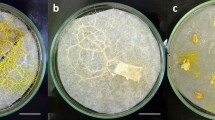Summary
Aphrophora alni andA. Salicis each have one bacterium in symbiosis. In smears they are specifically different.A. salide. has a long bacillus ;A. alni, a short and delicate bacterium. These germs produce the pigments of their host insects, the symbiote ofA. Salicis an ochre yellow pigment, like the colour of the insect, that ofA. alni red-brown which is the colour of this species. Morphological and physiological tests have shown that the isolation of the symbiotes has been correct.
Sulc and Buchner have illustrated mysterious yeasts or fungi in symbiosis with these insects. These supposed germs are placed in a new genus, Cicadomyces. Details are given to show how they do not represent living entities. Even the authors themselves have subsequently discarded their earlier nomenclature and have designated these bodies simply as symbiotes, feeling themselves doubtful regarding the real nature of the objects they have illustrated. These are best interpreted as protoplasmic debris or pathological products without any nucleus, but merely with chromatinous residues, without any membrane to resist disintegration and digestion and above all incapable of being cultivated and indicating any evidence with regard to their function. These Cicadomyces show a great contrast to real yeast-like symbiotes which have been also illustrated for comparison.
Similar content being viewed by others
Bibliography
S. Mahdihassan “Specific symbiotes of a few Indian scale-insects,”Cent. f. Bakt., 1929, II Abt.,78, 254–59.
Ditto “Classification of lac-insects from a physiological standpoint,”J. Sci. Assoc, Maharaja’s Col., Vizianagram, 1923,1, 68.
— “The symbiotes of some important lac-insects,”Arch, f. Prot. 1931,73, 164–77.
E. E. GreenCoccidœof Ceylon, Pt. V.
S. MahdihassanLac Secretion and Symbiotic Fungi—Some Studies in BioChemistry, Bangalore, 1924, 189.
Ditto “Symbionts specific of wax and pseudolac insects,”Arch. f. Prot., 1928,63, 20, Fig. 5.
— “Two varieties ofTachardina lobata,”Curr. Sci., 1946,15, 135–6.
— “Sur les différents symbiotes des cochenilles productrices ou non productrices de Cire,”C. R. Acad. Sci. Paris, 1933,196, 560–62.
— “Colour dimorphism inCoricoccus hibisci,”Curr. Sci.,” 1946,15, 197–98.
- “Pigmentbildende Bakterien aus einer entsprechend gefärbten Cicade,”Verhnd. b. Deutsch. Zool. Ges., 1939, 420–30.
- “Bacterial origin of some insect pigments,”Nature, 13th July 1946.
J. C. Chamberlin “Supplement to a monograph of 1ac insects,”Btn. Ent. Res., 1925,16, 31.
H. HauptDie Tierwelt Mitteleuropas,10, 156–57.
P. Buchner “Die symbiontischen Einrichtung der Zikaden,”Zeit. f. Morph, u. Okol., 1925,4, 111.
R. LydekkerThe Royal Natural History, Reissued 1922,6, 196, Fig. 3.
K. Sulc “Pseudovitellus,”Stzb. Böhm. Ges. Wiss., Prag., 1910, p. 36.
P. Buchner “Die Intrazellularen symbionten der Hemipteren,”Arch. f. Prot., 1912,26.
S. Mahdihassan “Insect tumours of bacterial origin,”Deccan Medical Journal, 1941. Gregson quoted fromJ. Path, and Bact., 1938.47, 143.
E. A. SteinhausInsect Microbiology, 1946.
Author information
Authors and Affiliations
Additional information
Communicated by Prof. M. R. Siddiqi,f.a.sc.
Rights and permissions
About this article
Cite this article
Mahdihassan, S. Specificity of bacterial symbiosis in aphrophorinæ. Proc. Indian Acad. Sci. 25, 155–162 (1947). https://doi.org/10.1007/BF03048149
Received:
Issue Date:
DOI: https://doi.org/10.1007/BF03048149




